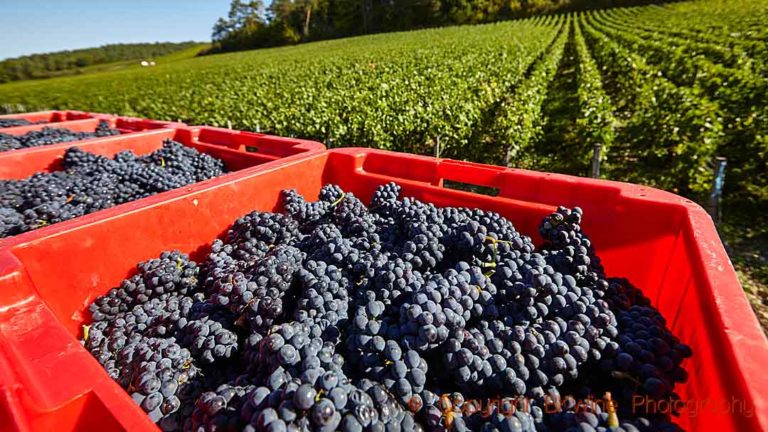This time of the year we usually get the first estimates of the current year’s wine production, 2021 is no different. It is the OIV that assembles the statistics of global wine production. This time it must have been particularly saddening. 2021 will be a year of (almost) record low production, a drop of 4% from 2020 that already was a small harvest. It is the three big countries – Italy, France and Spain – that have all been hit by bad weather almost all through the growing season. Worst hit was France with 27% less wine than in 2020. This means that Spain becomes the second biggest wine producer.
However, news is not all bad. The rest of the world has done well in terms of quantity. And many wine regions, also in the hard-hit European countries, will see good quality.
The recently announced figures from the International Organisation of Vine and Wine (OIV) reveal a gloomy picture for the world’s wine production in 2021. The numbers are, of course, preliminary at this early stage but are unlikely to change much.
This is a longer version of an article published on Forbes.com.
(Almost) record low wine production
The OIV estimates that the total global production of wine will reach around 250 million hectolitres (within a range of 247 to 253 Mhl). This number is very close to the harvest in 2017 of 247 Mhl, which was the smallest volume made in over twenty years.
2021 was a drop of 4% compared to the already small 2020. The small harvest in 2021 follows two years that have also given low volumes, 2019 with 258 Mhl and 2020 with 262 Mhl. All three years are well below the 20-year average of 269 Mhl.
Will we have a shortage of wine and big price increases?
However, these dramatic numbers do not necessarily mean that we are heading for a shortage of wine or that wine will become more expensive. There are many more factors to take into account.
First, we have, of course, wine consumption. During the soon two years of the pandemic the tendency seems to be that consumption is also declining, according to some preliminary numbers. A few other indicators point the other way, in particular the substantial sales increase in 2020 at the Swedish monopoly retail chain Systembolaget. But this is no doubt due to replacement retail purchases for consumption that would in a normal year have taken place in restaurants and bars.
It will take some time to get reliable numbers for 2021, but in 2020, wine consumption was estimated to have decreased by 3%.
Also, going back one more year, to 2018, we had, as a contrast to this year’s tiny volume, an exceptionally big harvest of 294 Mhl, the second-biggest volume in 20 years. So one has also to take into account, for example, stock volumes.
There is no need to sound the alarm just yet.
We should also keep in mind that the current sea shipping crisis, and to some extent also ground shipping, with dramatically increased shipping prices, may have a more significant effect on prices on imported wines. Inflation is making a comeback in some parts of the world which can also cause big price fluctuations. So if there are prices increases, it is not necessarily due to the small harvest in 2021.
Why so low production in 2021?
Let’s take a close look at some of the details tu understand what has happened this year.
The main reason for the very low production – in fact, the only reason – is the very small harvest in a few European countries, and in particular in the three big wine-producing countries, the world’s three biggest, Italy, France and Spain. The rest of the world did not do so badly at all, and sometimes even with very good volumes.
Wine Production in Europe
Italy, Spain and France made 79% of all wine in the EU. They also account for almost half of the global wine production, 45%. So, no wonder that their drops have a significant effect on the global numbers:
- Italy: -9% to 44.5 Mhl
- Spain: -14% to 35 Mhl
- France: -27% to 34.2 Mhl
In 2020 they together made 136.5 Mhl. In 2021 they made only 113.7 Mhl, a decrease of 22.8 Mhl or -17% collectively.
Italy is thus still the world’s biggest wine producer. But France has lost its second place and dropped to third due to its exceptionally poor harvest. Spain became the second-largest wine producer in 2021.
The almost catastrophic figures from France were caused by very unfavourable climatic conditions during most of the growing season: frost, hail, storms, and humidity in the summer (causing diseases). The French wine production is the lowest since 1957.
The drops in Italy and Spain have similar causes, but less severe.
The other EU countries faired, in general, rather better, but with a few extraordinary gains and losses. In places four to ten:
- Germany, 8.8 Mhl, +4%
- Portugal, 6.5 Mhl, +1%
- Romania, 5.3 Mhl, +37% (!)
- Hungary, 3.1 Mhl, +6%
- Austria, 2.3 Mhl, -4%
- Greece, 1.7 Mhl, -26% (!)
- Bulgaria, 0.9 Mhl, +7%
The remaining of the 27 countries together made 2.7 Mhl, or 1.9% of the EU total.
The total wine production of the EU 27 reached 145 Mhl, a drop of 13% compared to 2020 and very close to the record low in 2017 of 141 Mhl.
EU will account for around 58% of the total world wine production.
And the rest of the world?
The rest of the world shows much more positive wine production numbers.
The top wine producing countries outside the EU:
- USA, 24.1 Mhl, +6%
- Australia, 14.2 Mhl, +30%
- Chile, 13.4 Mhl, +30%
- Argentina, 12.5 Mhl, +16%
- South Africa, 10.6 Mhl, +2%
- China, no estimate but was 6.6 Mhl in 2020
- Russia, 4.5 Mhl, +2%
- Brazil, 3.6 Mhl, +60%
- New Zealand, 2.7 Mhl, -19%
- Georgia, 2.2 Mhl, +22%
- Moldova, 1.1 Mhl, +20%
- Switzerland, 0.8 Mhl, -10%
- Uruguay, 0.7 Mhl, +8%
- Ukraine, no estimate but was 0.7 Mhl in 2020
The USA, the world’s third-biggest wine producer, increased the wine volume by 6% to reach 24.1 Mhl. (Note: China has not reported any numbers, but the OIV expects it to continue the trend from last year, when it was estimated to be the world’s tenth biggest producer, with shrinking numbers.)
Australia, Chile, Argentina and South Africa, who usually jockey for positions five to eight in the world ranking, did well, or very well in some cases: up 30% for both Australia and Chile (to 14.2 Mhl and 13.4 Mhl respectively, a 20-year record for Chile), +16% for Argentina (12.5 Mhl), and a more modest +2% for South Africa (10.6 Mhl).
The very impressive growth numbers for South America is mostly due to exceptionally favourable weather, with an absence of El Niño. South Africa is continuing its recovery from the serious drought it had a few years ago. Australia too can be seen as recovering after two years of drought and wildfires. New Zealand, on the contrary, saw its harvest reduced due to spring frosts.
The southern hemisphere has thus produced a very big harvest reaching 59 Mhl, +19%, which is a record for the southern half of the world. It now represents 23% of the global production of wine, almost one quarter. However, their total is “still” just about comparable to Italy alone in a good year.
The world’s biggest wine producing countries in 2021
If we collate all this information we have the world’s top-ten wine producing countries in 2021 (early estimates, top 18 actually):
- Italy: -9% to 44.5 Mhl
- Spain: -14% to 35 Mhl
- France: -27% to 34.2 Mhl
- USA, 24.1 Mhl, +6%
- Australia, 14.2 Mhl, +30%
- Chile, 13.4 Mhl, +30%
- Argentina, 12.5 Mhl, +16%
- South Africa, 10.6 Mhl, +2%
- Germany, 8.8 Mhl, +4%
- Portugal, 6.5 Mhl, +1%
- China, no estimate but was 6.6 Mhl in 2020, so they are likely to drop out of the top-ten this year
- Romania, 5.3 Mhl, +37% (!)
- Russia, 4.5 Mhl, +2%
- Brazil, 3.6 Mhl, +60%
- Hungary, 3.1 Mhl, +6%
- New Zealand, 2.7 Mhl, -19%
- Austria, 2.3 Mhl, -4%
- Georgia, 2.2 Mhl, +22%
In summary:
- Record low world-wide wine production due to small harvests in Italy, Spain, France
- Spain overtakes France to become the second biggest producer, after Italy
- The US is still a solid number four
- Very good volumes in the southern hemisphere, the four biggest countries are now well ahead of Germany
- China is likely to drop out of the top-ten list if the decline continues, as the OIV expects
What about the quality?
Quality-wise the news is much better. Even in the hard-hit European countries there are many signs pointing to a good or very good quality, as you can read in this very short harvest report from some of the wine regions that we have visited this season on our wine tours. (Yes, the wine tours are on again!)
All data come from the OIV.












